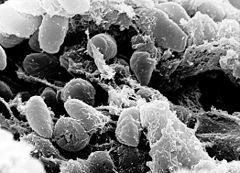
Sylvatic plague is an infectious bacterial disease caused by the plague bacterium (Yersinia pestis) that primarily affects rodents, such as prairie dogs. It is the same bacterium that causes bubonic and pneumonic plague in humans. Sylvatic, or sylvan, means 'occurring in woodland,' and refers specifically to the form of plague in rural wildlife. Urban plague refers to the form in urban wildlife.
It is primarily transmitted among wildlife through flea bites and contact with infected tissue or fluids. Sylvatic plague is most commonly found in prairie dog colonies and some mustelids, like the black-footed ferret.[1][2]
- ^ Abbott, R.C.; Rocke, T.E (2012). "Plague: U.S. Geological Survey Circular 1372".
- ^ "Sylvatic Plague". www.usgs.gov. Retrieved 2021-02-19.